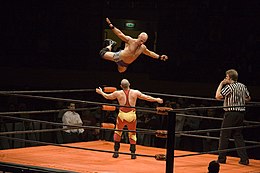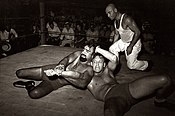
Back Rofstoei Afrikaans مصارعة محترفة Arabic Llucha llibre profesional AST Peşəkar güləş Azerbaijani حرفهای گولش AZB Wrestling BAR Кеч Bulgarian পেশাদারি কুস্তি Bengali/Bangla Katch Breton Lluita lliure professional Catalan
This article possibly contains original research. (July 2023) |

| Part of a series on |
| Professional wrestling |
|---|
 |
Professional wrestling (often referred to as pro wrestling, or simply, wrestling) is a form of athletic theater[2] centered around mock combat and based on the premise that performers are competitive wrestlers. Professional wrestling is distinguished from amateur wrestling by its scripted outcomes and emphasis on entertainment and storytelling over genuine competition.[3] The staged nature of matches is an open secret: Through a practice known as kayfabe, both wrestlers and spectators—as well commentators and journalists—maintain the pretense that the performances are bona fide competitions,[4] which is likened to the suspension of disbelief employed when engaging with fiction.[3]
Professional wrestlers perform as characters and usually maintain what is known in the industry as a "gimmick" — the persona, style and traits conveyed by distinctive attire, stage name, entrance theme music, and other distinguished characteristics and creative flourishes. Matches are the primary vehicle for advancing storylines, which typically center on interpersonal conflicts, or feuds, between heroic "faces" and villainous "heels". A wrestling ring, akin to the platform used in boxing, serves as the main stage; additional scenes may be recorded for television in backstage areas of the venue, in a format similar to reality television. Performers generally integrate authentic wrestling techniques and fighting styles with choreography, stunts, improvisation, and dramatic conventions designed to maximize entertainment value and audience engagement.[1]
Professional wrestling as a performing art evolved from the common practice of match-fixing among American wrestlers in the 19th century, who later sought to make matches shorter, more entertaining, and less physically taxing. As the public gradually realized and accepted that matches were predetermined, wrestlers responded by increasingly adding melodrama, gimmickry, and outlandish stunt work to their performances to further enhance the spectacle. By at least the early 20th century, professional wrestling had diverged from the competitive sport to become an artform and genre of sports entertainment.
Professional wrestling is performed around the world through various "promotions", which are roughly analogous to production companies or sports leagues. Promotions vary considerably in size, scope, and creative approach, ranging from local shows on the independent circuit, to internationally broadcast events at major arenas. The largest and most influential promotions are in the United States,[2] Mexico, Japan, and Europe (particularly the United Kingdom, Germany/Austria and France),[4] which have each developed distinct styles, traditions, and subgenres within professional wrestling.[5] Many professional wrestlers also perform as free agents and make appearances for different promotions.
Professional wrestling has developed its own culture and community, including a distinct vernacular. It has achieved mainstream success and influence within popular culture, with many terms and jargon, tropes, and concepts being referenced in everyday language and in film, music, television, and video games. Numerous professional wrestlers have become national or international icons with recognition by the broader public, with some finding further fame and success through other performing arts, such as acting.
- ^ a b Levi, Heather J. (2001). Masked struggle: An ethnography of Lucha Libre (PhD thesis). New York University. p. 57.
In the [flying crossbody] ... [the defender] lift her arms slightly, in order to catch her opponent and minimize the impact of the technique.
- ^ a b Eero Laine (2017). "Stadium-sized theatre: WWE and the world of professional wrestling". In Chow et al. (2017). Performance and Professional Wrestling, p. 39: "The business of professional wrestling is the business of theatre. Even if on the surface professional wrestling seems anathema to theatrical sensibilities, it is hard to deny the formal similarities. After all, professional wrestling is scripted entertainment performed live in front of an audience by actors portraying characters."
- ^ a b "It's all fake, right? A professional wrestler explains everything". ABC News. 2017-10-04. Archived from the original on 2022-11-16. Retrieved 2024-01-30.
"Fake" is the wrong word. You don't call Wuthering Heights or Star Wars "fake", you call it fiction.
- ^ a b Shoemaker (2013). Benjamin, p. 27: "... the people who were clued in were happy to play along to further their enjoyment."
- ^ "Promotions Database". Cagematch.net. 12 July 2024. Retrieved 12 July 2024.